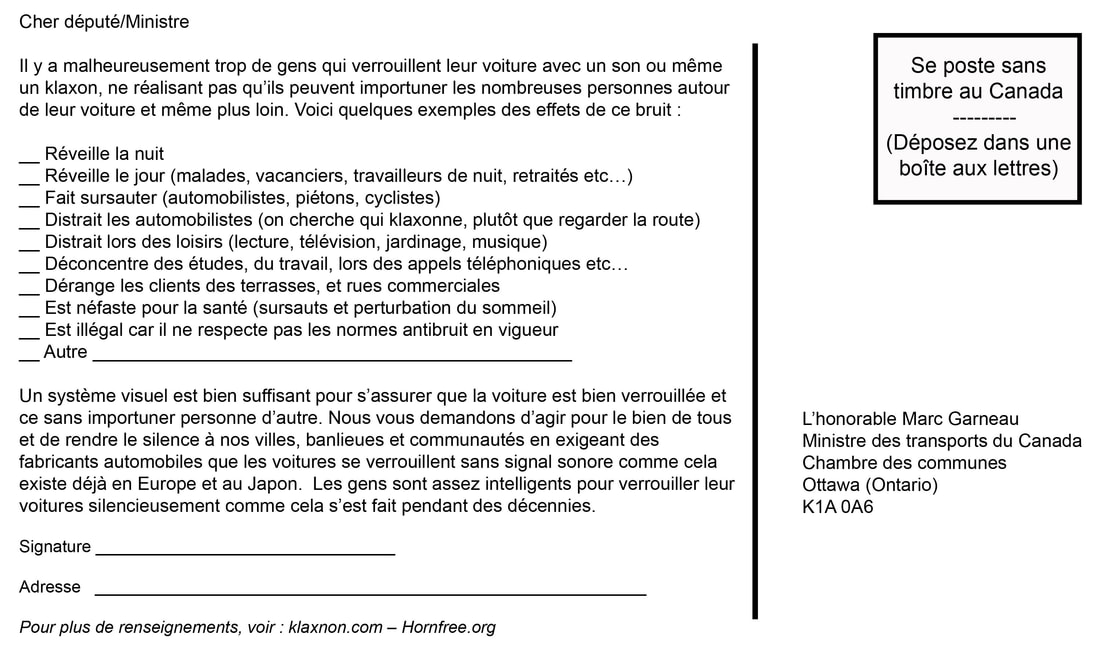|
As the Silence the Horns project moves into its final year, some supporters have fallen away. But among those who remain in touch, many advocate in one way or another for reduction in unnecessary noise and increased awareness about the benefits of developing quieter products. Some have written articles, and some have written books. Some are involved with citizen science projects. One colleague succeeded in convincing a school board to implement a curriculum focused on sound, health, and the environment. Thousands of miles away, another colleague attempted to accomplish the same feat.
A longtime ally in Montreal initiated a postcard campaign to address horn use with lock signaling (above). According to the instructions, which are in French, the illustration above (larger on the Klaxnon page) is available at no cost to anyone who wants to print and photocopy it. Canadian residents can order the postcard, which has the following on the back. Klaxnon will provide labels and instructions.

An abbreviated English translation reads:
Dear MP / Minister:
There are unfortunately too many people who lock their car with a sound or even a horn, not realizing that they can disturb many people in the immediate area and even further. Here are some examples of the effects of this noise:
__ People awakened at night
__ People awakened during the day (sick, vacationers, night workers, pensioners, etc.)
__ Startling to motorists, pedestrians, and cyclists
__ Distraction to motorists (looking for who honks, rather than looking at the road)
__ Distraction at leisure (reading, television, gardening, music)
__ Distraction during studies, work, phone calls, etc.
A visual system is good enough to ensure that the car is locked without disturbing others. We ask you to act for the good of all
and silence our cities, suburbs and communities by demanding that
manufacturers create cars that lock without a sound signal as they do in Europe and Japan. People are smart enough to lock their
cars silently as has been done for decades.

|
Another supporter, who lives in a residential complex with a high level of vehicle noise of all kinds, described a random act of kindness in the form of a note posted by neighbor (above).
"One of my neighbors in the back was actually being considerate last night," he wrote. "He left a note where everyone could see it, letting us know he was going to have a party. The guests all parked down along the street and were extremely loud walking back and forth into the back. I had to listen to loud white noise all night, and at 2:30 a.m. one of them drove all the way down the street honking.
"HOWEVER, because of this note, I knew what to expect, and it wasn't as bad as it could have been."
A couple from Arizona live in a beautiful residential community that would be peaceful if it weren't for the frequent sounds of horns honking as residents lock their cars. In December, they bought a new Nissan LEAF, which they loved except for the sound that Nissan elected to use for its VSP, a sound that doesn't sound like an engine would sound. A few weeks later, I received an email with this message:
"Our neighborhood is a tiny bit quieter now.
- JN"
Attached was an instruction manual he'd written documenting the process of quieting the sound.
In March, an ally from the American Northwest wrote, "Tonight I called the internet radio show Midnight in the Desert and brought up the audible car lock problem."
"The call is attached."
- F
I also heard from a friend I met through noise advocacy work who lives in such a quiet area that he says he only hears honking horns when he goes to town to shop and hears cars honk as people lock them. We've often marveled about the lost soundscapes in parking lots, where one could count on finding peace and respite before horns were used for lock signaling.
Recalling an especially beautiful parking lot, he said, "The parking lot for the hospital out on the southern Oregon coast where I worked for twenty-four years provided an excellent green space as well as accommodating hundreds of cars. This hospital is surrounded by stately Douglas Fir trees with an understory of tall Sword Ferns, but there were also plantings of trees and shrubs throughout the parking lot. It was a great place to take a power nap in the front seat of one’s car, followed up by a lap around the hospital grounds. Without this very relaxing setting, my employment at this hospital would have been significantly diminished."
He added that the same parking lot had "proved to be an integral part of my 'life support system' enabling me to endure the tedious, yet dangerously boring microscopic work I did for 24 years. I say “dangerous” not with reference to my safety but for the well-being of the patient. My sole mission was to detect premalignant and malignant cellular changes in various medical specimens, and one could not afford to be asleep at the wheel. The parking lot was where I was able to re-group and recharge my battery."
|